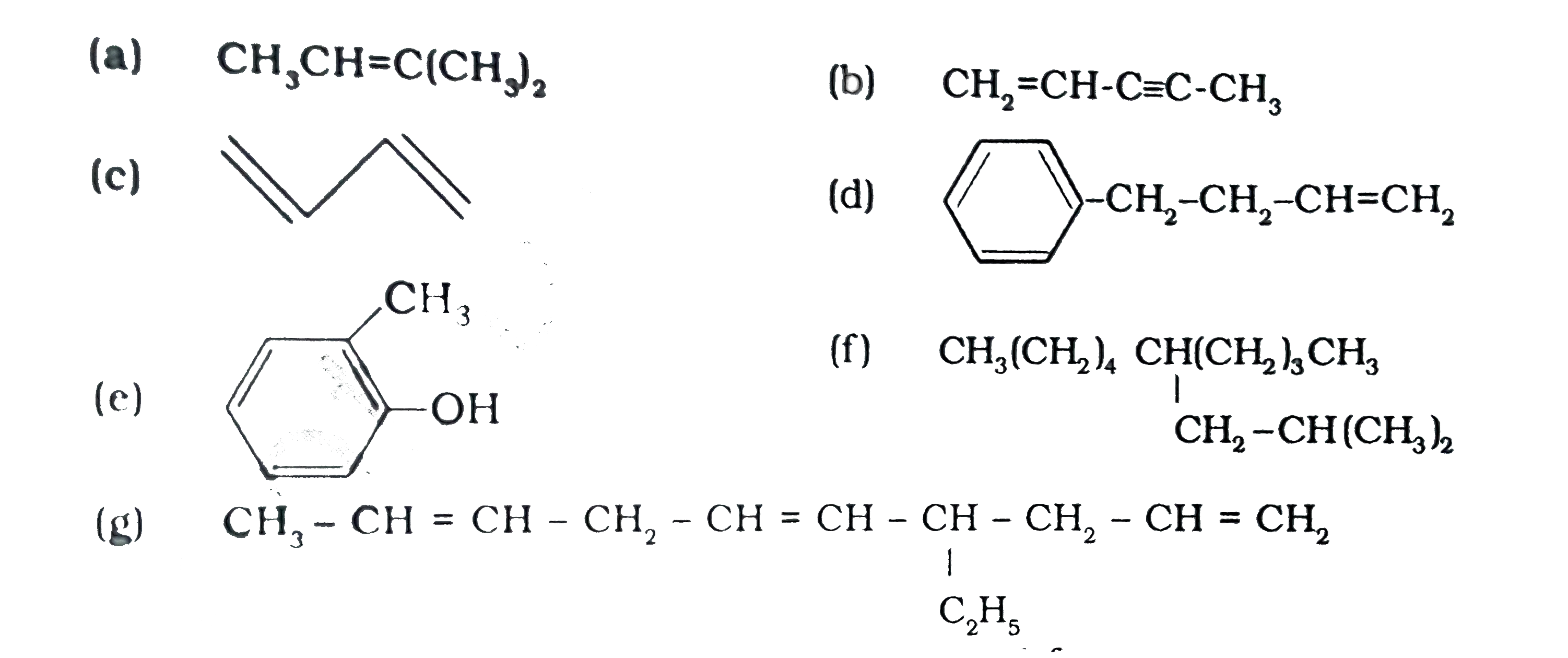Complete Solutions to EXERCISE of chapter HYDROCARBONS of Class 11 book with complete answers and questions
| Class 11 | CHEMISTRY |
| Chapter | HYDROCARBONS |
| NCERT | EXERCISE |
| Number Of Questions | 25 |
| Academic Year | 2023-24 |
How do you account for the formation of ethane during chlorination of methane ?
03:27View SolutionWrite IUPAC names of the following compounds : (a) `CH_(3)CH=C(CH_(3))_2`
(b) `CH_(2)=CH-C-=C-CH_(3)`
(c )
(d)
(e )
`{:(CH_(3)(CH_(2))_4CH(CH_(2))_3CH_(3)),(" "|),(" "CH_(2)-CH(CH_(3))_2):}`07:55View SolutionFor the following compounds, write structural formulas and IUPAC names for all possible isomers having the number of double or triple bond as indicated:
(a) `C_(4)H_(8)`(one double bond)
(b) `C_(5)H_(8)` (one triple bond)05:31View SolutionWrite IUPAC names of the products obtained by the ozonolysis of the following compounds:
(i) Pent-2-ene (ii) 3,4-Dimethyl-hept-3-ene
(iii) 2-Ethylbut-1-ene (iv) 1-Phenylbut-1-ene09:33View SolutionAn alkene ‘A’ on ozonolysis gives a mixture of ethanal and pentan-3-one. Write structure and IUPAC name of ‘A’.
03:54View SolutionAn alkene ‘A’ contains three C – C, eight C – H `(sigma)` bonds and one C – C `(pi)` bond. ‘A’ on ozonolysis gives two moles of an aldehyde of molar mass 44 u. Write IUPAC name of ‘A’.
05:39View SolutionPropanal and pentan-3-one are the ozonolysis products of an alkene? What is the structural formula of the alkene?
03:58View SolutionWrite chemical equations for combustion reaction of the following hydrocarbons:
(i) Butane
(ii) Pentene
(iii) Hexyne
(iv) Toluene03:34View SolutionDraw the cis and trans structures of hex-2-ene. Which isomer will have higher b.p. and why?
03:53View SolutionWhy is benzene extra ordinarily stable though it contains three double bonds?
02:00View SolutionWhat are the necessary conditions for any system to be aromatic?
01:36View SolutionExplain why the following systems are not aromatic?
 04:07View Solution
04:07View SolutionHow will you convert benzene into
(i) p-nitrobromobenzene
(ii) m-nitrochlorobenzene
(iii) p -nitrotoluene
(iv) acetophenone09:19View SolutionIn the alkane `H_3C-CH_(2)-C(CH_(3))_2-CH_(2)-CH(CH_(3))_2`, identify `1^(@),2^(@),3^(@),` carbon atoms and give the number of H atoms bonded to each one of these.
03:13View SolutionWhat effect does branching of an alkane chain has on its boiling point?
02:08View SolutionAddition of HBr to propene yields 2-bromopropane, while in the presence of benzoyl peroxide, the same reaction yields 1-bromopropane. Explain and give mechanism.
09:17View SolutionWrite down the products of ozonolysis of 1, 2-dimethylbenzene (o-xylene). How does the result support Kekulé structure for benzene?
03:31View SolutionArrange benzene, n-hexane and ethyne in decreasing order of acidic behaviour. Also give reason for this behaviour.
03:17View SolutionWhy does benzene undergo electrophilic substitution reactions easily and nucleophilic substitutions with difficulty?
02:17View SolutionHow would you convert the following compounds into benzene?
(i) Ethyne
(ii) Ethene
(iii) Hexane04:53View SolutionWrite structures of all the alkenes which on hydrogenation give 2-methylbutane.
02:19View SolutionArrange the following set of compounds in order of their decreasing relative reactivity with an electrophile, E+
(a) Chlorobenzene, 2,4-dinitrochlorobenzene, p-nitrochlorobenzene
(b) Toluene, `p-H_3C–C_6H_4–NO_(2), p-O_2N–C_6H_4–NO_2`.05:09View SolutionOut of benzene, m–dinitrobenzene and toluene which will undergo nitration most easily and why?
04:06View SolutionSuggest the name of a Lewis acid other than anhydrous aluminium chloride which can be used during ethylation of benzene.
01:28View SolutionWhy is Wurtz reaction not preferred for the preparation of alkanes containing odd number of carbon atoms? Illustrate your answer by taking one example.
03:50View Solution
EXERCISE questions and complete solutions for chapter HYDROCARBONS of NCERT CHEMISTRY(HINGLISH) of Class 11
